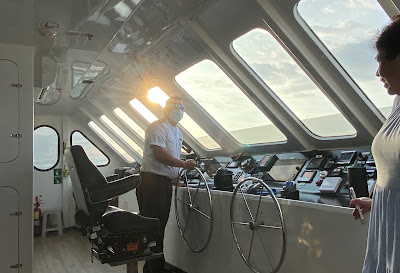Thursday, June 30, 2022
ECUADOR, GALAPAGOS ISLANDS: CROSSING THE EQUATOR
Sunday, June 26, 2022
ECUADOR, GALAPAGOS ISLANDS: ISABELA ISLAND - TAGUS COVE PANGA RIDE AND EQUATOR CROSSING
March 24, 2022, Afternoon and Evening
In the afternoon we took a panga trip to Vincente Roca Point, the northernmost site on Isabela Island. It is supposed to be a fantastic area for snorkeling, but the water was very murky.
Wednesday, June 22, 2022
ECUADOR, GALAPAGOS ISLANDS: ISABELA ISLAND - TAGUS COVE HIKE
Saturday, June 18, 2022
ECUADOR, GALAPAGOS ISLANDS: FERNANDINA ISLAND - ESPINOZA POINT
March 23, 2022, Afternoon
The last expedition of the day was a walking excursion on Fernandina Island, an island next to Isabela Island, where we had spent the morning and the previous day. Our naturalist guide Fernanda told us Fernandina is her favorite island in the Galapagos, and not just because of the similarity to her name. She was excited to show it to us.
With the good omen of a rainbow behind us, we set out in the pangas for a dry docking on Fernandina Island. Our two-hour visit there may be our favorite experience of the entire Galapagos trip, and possibly one of our favorite travel experiences of all time.
Tuesday, June 14, 2022
ECUADOR, GALAPAGOS ISLANDS: ISABELA ISLAND - URBINA BAY
Wednesday, March 23, 2022, Morning
Every night after dinner, the crew would put the next day's itinerary on a giant TV screen so we could plan clothing, etc. Our second day would include two landings: one wet and one dry.
Friday, June 10, 2022
ECUADOR, GALAPAGOS ISLANDS: ISABELA ISLAND - PUNTA MORENO AND ELIZABETH BAY
March 22, 2022
However, the next morning I was able to keep my breakfast down and join the others on an inflatable motorized raft, which I learned is called a panga, for an expedition to explore the coastline of Punta Moreno on the island of Isabela. There it is in the distance, as seen from our catamaran:
Monday, June 6, 2022
ECUADOR: TRAVELING TO THE GALAPAGOS ISLANDS AND VISITING BALTRA AND SANTA CRUZ ISLANDS
March 21, 2022
 |
| Map from here |
Thursday, June 2, 2022
ECUADOR: QUITO-IN-A-DAY
March 21, 2022
Quito is the capital and largest city in Ecuador. Situated in a valley in the Andean foothills at 9,350 feet, it is the second-highest capital city in the world (La Paz, Bolivia, sits at 11,942 feet) and the capital city closest to the equator. It is the only capital city next to an active volcano, Pichinca, which stands at 15,728 feet. Its last major eruption was in 1660, but it did puff a fair amount of ash onto Quito in 1999. Quito has, however, had a significant number of large-magnitude earthquakes in the last 100 or so years, including two that were stronger than 8.0 in magnitude: 8.8 in 1906, 8.2 in 1979, and nine stronger than 7.0 since 1942. Yikes.
Founded by the Spanish in 1534 on the ruins of an Inca city, Quito proper covers 143 square miles and has a population of 2.8 million, and we had about ten hours to see it all.
In the morning we met up with Terry and Geneil and enjoyed an upgraded breakfast on the "club floor" with them, (Remember, Terry had been upgraded because it was his birthday.)
Afterwards we gathered in the lobby with the other two couples who were joining our group, Brian and Renee Bascom and Ward and Norma Robinson, who had arrived in Quito in the last day or so.
A guide and driver picked up the eight of us and we were on the road by 9:00 AM. Our first stop was the Itanim Middle of the World Museum.












.JPG)
.JPG)

.JPG)

.JPG)








.JPG)


.JPG)

.JPG)




.JPG)


.JPG)

